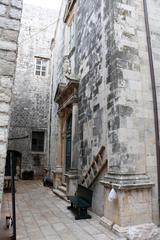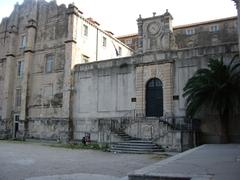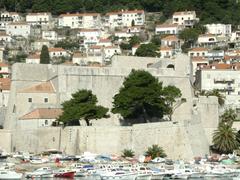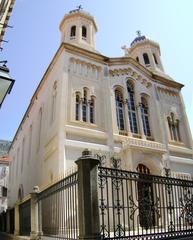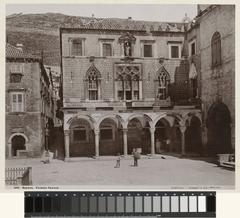Maritime Museum Dubrovnik: Visiting Hours, Tickets, and Travel Guide
Date: 04/07/2025
Introduction
Set within the imposing walls of Dubrovnik’s UNESCO-listed Old Town, the Maritime Museum Dubrovnik offers visitors a captivating journey through centuries of Adriatic seafaring and trade. Housed in the historic Fort St John (Sveti Ivan), the museum is a testament to the city’s status as a maritime powerhouse during the era of the Republic of Ragusa. With over 11,000 artifacts—including navigational instruments, ship models, and treasures from shipwrecks—the museum provides an immersive look at how Dubrovnik’s sailors, merchants, and shipbuilders shaped Mediterranean and global maritime history. This guide covers everything you need to plan your visit: opening hours, ticket details, accessibility, guided tours, nearby attractions, and essential travel tips to make the most of your experience at one of Dubrovnik’s top historical sites (dumus.hr, thecrazytourist.com, visitdubrovnik.hr, muzej-maritim.hr).
Table of Contents
- Introduction
- Historical Background
- Museum Collections and Exhibitions
- Fort St John: Architectural and Historical Significance
- Visitor Information
- Frequently Asked Questions (FAQs)
- Summary and Recommendations
- References
Historical Background
Origins and Foundation
The Maritime Museum Dubrovnik was established in 1949, growing out of efforts to preserve the city’s seafaring legacy. Its collections began with donations from citizens and artifacts exhibited in the 1941 “Dubrovnik Seafaring through the Ages” display. In 1952, the museum found its permanent home in the upper floors of Fort St John, a strategic fortress overlooking the harbor (dumus.hr, tzdubrovnik.hr).
Dubrovnik’s Maritime Heritage
Historically known as Ragusa, Dubrovnik rose to prominence as a maritime republic, rivaling Venice and Genoa. Its merchant fleet was among Europe’s largest in the 16th century, with Dubrovnik’s “argosy” ships becoming synonymous with merchant vessels in English literature (absolute-croatia.com). The city’s maritime code, the “Statute of Dubrovnik,” set standards for navigation and trade, helping maintain independence and prosperity through diplomacy, neutrality, and innovation (worldcityhistory.com).
Museum Collections and Exhibitions
Permanent Collections
The museum’s artifacts are organized across two floors and into fifteen thematic collections, offering a comprehensive view of Dubrovnik’s maritime evolution (dumus.hr):
- Navigational Instruments and Ship Equipment: Original compasses, astrolabes, sextants, and ship’s gear.
- Historic Maps and Documents: Ship logs, legal codes, and navigation charts spanning centuries.
- Ship Models and Dioramas: Detailed replicas of Dubrovnik’s merchant ships, warships, and fishing boats.
- Submarine Archaeological Finds: Artifacts discovered in Adriatic shipwrecks, including amphorae, anchors, and personal belongings.
- Paintings and Photographs: Portraits of captains and scenes depicting Dubrovnik’s bustling port.
The museum also hosts temporary exhibitions on topics such as Adriatic piracy, underwater archaeology, and the influence of global trade.
Thematic Displays
- The Republic of Ragusa’s Golden Age: Exhibits highlight the city’s extensive trade networks and diplomatic achievements.
- Shipbuilding and Navigation: Interactive displays explain ship construction and celestial navigation.
- Maritime Life: Artifacts and multimedia displays explore sailors’ daily routines, uniforms, and superstitions.
Fort St John: Architectural and Historical Significance
Constructed starting in 1346 and completed in the late 16th century, Fort St John was a linchpin in Dubrovnik’s defenses against naval threats (tzdubrovnik.hr). Its robust architecture, panoramic Adriatic views, and layers of history create an atmospheric backdrop for the museum’s exhibits, allowing visitors to experience firsthand the interplay between maritime activity and urban defense (godubrovnik.guide).
Visitor Information
Visiting Hours
- April to October: Daily, 9:00 AM – 7:00 PM
- November to March: Daily, 9:00 AM – 5:00 PM (or 3:00 PM, depending on sources)
- Holidays: Closed on Christmas, New Year’s Day, and the Feast of St. Blaise; reduced hours on Christmas Eve and New Year’s Eve (Dubrovnik Museums).
Always check the official website for up-to-date hours before your visit.
Ticket Prices
- Adults: 40 HRK (~€5.5)
- Students/Seniors: 20–25 HRK (~€2.7–€3.3)
- Children under 7: Free
- Family and group discounts available
Tickets can be purchased at the entrance or online via the Dubrovnik Museums website. Combination tickets (such as the Dubrovnik Card) are available and include entry to multiple historical sites (Showcasing the Globe).
Accessibility
While the museum has made efforts to improve accessibility with ramps and elevators, some areas remain challenging due to the fortress’s historic structure. Visitors with mobility needs should contact the museum in advance for assistance.
Guided Tours and Special Events
- Guided Tours: Available in multiple languages; advance booking recommended for groups.
- Audio Guides: Offered in several languages.
- Workshops and Educational Programs: Regularly scheduled for families and students.
- Temporary Exhibitions: Check the museum’s website for current and upcoming special displays.
Travel Tips and Nearby Attractions
- Getting There: Located in St. John’s Fortress at Dubrovnik Old Harbour, easily accessible on foot from the Old Town or via public transport.
- Photography: Allowed (no flash).
- Facilities: Restrooms on site; museum shop offers maritime-themed souvenirs.
- Nearby Attractions: Combine your visit with the Dubrovnik Aquarium (in the same fortress), city walls, Rector’s Palace, Franciscan Monastery, and Old Port ferry terminals.
Frequently Asked Questions (FAQs)
How long does a typical visit take?
Plan for 1–2 hours; maritime enthusiasts may want more time.
Is the museum suitable for children?
Yes, the engaging displays and ship models appeal to families.
Are guided tours available?
Yes, in multiple languages; book in advance for groups.
Can I buy tickets online?
Yes, via the official website.
Is the museum wheelchair accessible?
Partially; contact ahead for assistance with mobility needs.
Is photography allowed?
Yes, without flash.
Summary and Recommendations
The Maritime Museum Dubrovnik offers a comprehensive and engaging exploration of the city’s seafaring past, all set within the evocative Fort St John. From medieval navigation to underwater archaeological finds, the museum’s collections bring to life the innovations, diplomacy, and resilience that defined the Republic of Ragusa. With flexible visiting hours, affordable tickets, and options for guided or self-guided tours, the museum is accessible and rewarding for all visitors. For the best experience, combine your museum visit with other nearby attractions and consider using the Dubrovnik Card for savings and convenience. For up-to-date information, events, and insider tips, consult the official museum website or download the Audiala app (dumus.hr, thecrazytourist.com, muzej-maritim.hr, visitdubrovnik.hr).
References
- Maritime Museum Dubrovnik: About Museum
- 15 Best Things to Do in Dubrovnik – The Crazy Tourist
- Visit Dubrovnik Official Tourism Site
- Maritime Museum Dubrovnik Official Website
- Dubrovnik Tourism: Maritime Museum
- Absolute Croatia: Maritime Museum Dubrovnik
- World City History: The Fascinating History of Dubrovnik
- Destinations AI: Maritime Museum Dubrovnik
- Arrival Guides: National Maritime Museum Dubrovnik
- Showcasing The Globe: Tips for Your First Visit to Dubrovnik


